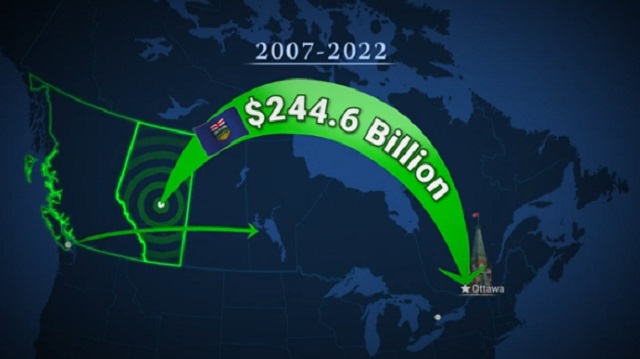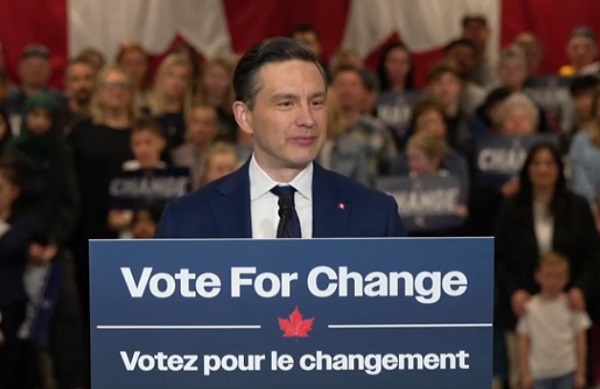Alberta
Albertans continue to contribute disproportionately to Canadian federalism

From the Fraser Institute
By Tegan Hill
Net contribution totaled $244.6 billion between 2007 and 2022
Between 2007 and 2022, Albertans continued to contribute disproportionately to Canadian federalism in terms of the amount of federal taxes paid versus federal spending in the province, finds a new study published today by the Fraser Institute, an independent non-partisan Canadian think-tank.
“It’s clear that Albertans continue to disproportionately contribute to the economic success of the country and to federal finances,” said Tegan Hill, director of Alberta Policy at the Fraser Institute and co-author of Understanding Alberta’s Outsized Contribution to Confederation.
Overall, from 2007 and 2022, Albertans’ contributed $244.6 billion to the federal government in taxes and other payments in excess of the money Ottawa spent or transferred to Alberta – more than five times as much as was contributed (on net) by either British Columbians or Ontarians. The other seven provinces, and most notably Quebec were net recipients of federalism, meaning the amount of revenues collected by the federal government in those provinces was exceeded by the amount of money spent or transferred by Ottawa back to the provinces.

“When Alberta’s economy is strong and prosperous, it benefits the entire nation,” commented Hill.
In 2022, Alberta’s inflation-adjusted GDP growth was the fastest in the country (5 per cent), it also reported the fastest private sector employment growth (7.8 per cent), the highest level of business investment per private sector worker ($36,412) and had the highest net interprovincial migration (56,245 people).
“It is the economic success of Alberta that leads to Albertans contributing more to Canadian federalism than other provinces, which is absolutely something to be encouraged rather than discouraged,” said Hill.
- When Alberta is economically strong, all Canadians benefit, because money is redistributed to other parts of Canada.
- In 2022, despite restrictive federal policies, Alberta continued to contribute disproportionately to the federation.
- Alberta’s 5.0% real GDP growth rate was the fastest in Canada in 2022, accounting for 17.9% of Canada’s real GDP growth, despite being home to 11.6% of the population.
- In 2022, 56,245 Canadian residents relocated to Alberta, representing more than 75% of total net in-migration within Canada.
- Alberta reported the fastest private sector employment growth among the provinces (7.8%) in 2022, accounting for 19.2% of private sector jobs created in Canada.
- Per private sector worker, Alberta attracted $36,412 of business investment, more than double the national average (excluding Alberta).
- From 2007 to 2022, Alberta’s net contribution to the federal finances totalled $244.6 billion—more than five times as much as BC’s ($46.9 billion) or Ontario’s ($41.9 billion). In 2022, Alberta contributed $14.2 billion more to federal revenues than it received back in federal spending.
- If Alberta were an “average contributor” based on the other provinces, rather than a large net contributor, the federal government would have had a fiscal shortfall of $16.9 billion in 2022. For perspective, to cover this net revenue loss, the federal GST rate would need to increase from 5.0% to 7.2%.
- Put simply, without Alberta’s oversized contribution to the federation, Canada would be worse off. To benefit all Canadians, the federal government should focus on supportive policies, not restrictive ones.
Authors:
Alberta
Low oil prices could have big consequences for Alberta’s finances

From the Fraser Institute
By Tegan Hill
Amid the tariff war, the price of West Texas Intermediate oil—a common benchmark—recently dropped below US$60 per barrel. Given every $1 drop in oil prices is an estimated $750 million hit to provincial revenues, if oil prices remain low for long, there could be big implications for Alberta’s budget.
The Smith government already projects a $5.2 billion budget deficit in 2025/26 with continued deficits over the following two years. This year’s deficit is based on oil prices averaging US$68.00 per barrel. While the budget does include a $4 billion “contingency” for unforeseen events, given the economic and fiscal impact of Trump’s tariffs, it could quickly be eaten up.
Budget deficits come with costs for Albertans, who will already pay a projected $600 each in provincial government debt interest in 2025/26. That’s money that could have gone towards health care and education, or even tax relief.
Unfortunately, this is all part of the resource revenue rollercoaster that’s are all too familiar to Albertans.
Resource revenue (including oil and gas royalties) is inherently volatile. In the last 10 years alone, it has been as high as $25.2 billion in 2022/23 and as low as $2.8 billion in 2015/16. The provincial government typically enjoys budget surpluses—and increases government spending—when oil prices and resource revenue is relatively high, but is thrown into deficits when resource revenues inevitably fall.
Fortunately, the Smith government can mitigate this volatility.
The key is limiting the level of resource revenue included in the budget to a set stable amount. Any resource revenue above that stable amount is automatically saved in a rainy-day fund to be withdrawn to maintain that stable amount in the budget during years of relatively low resource revenue. The logic is simple: save during the good times so you can weather the storm during bad times.
Indeed, if the Smith government had created a rainy-day account in 2023, for example, it could have already built up a sizeable fund to help stabilize the budget when resource revenue declines. While the Smith government has deposited some money in the Heritage Fund in recent years, it has not created a dedicated rainy-day account or introduced a similar mechanism to help stabilize provincial finances.
Limiting the amount of resource revenue in the budget, particularly during times of relatively high resource revenue, also tempers demand for higher spending, which is only fiscally sustainable with permanently high resource revenues. In other words, if the government creates a rainy-day account, spending would become more closely align with stable ongoing levels of revenue.
And it’s not too late. To end the boom-bust cycle and finally help stabilize provincial finances, the Smith government should create a rainy-day account.
Alberta
Governments in Alberta should spur homebuilding amid population explosion

From the Fraser Institute
By Tegan Hill and Austin Thompson
In 2024, construction started on 47,827 housing units—the most since 48,336 units in 2007 when population growth was less than half of what it was in 2024.
Alberta has long been viewed as an oasis in Canada’s overheated housing market—a refuge for Canadians priced out of high-cost centres such as Vancouver and Toronto. But the oasis is starting to dry up. House prices and rents in the province have spiked by about one-third since the start of the pandemic. According to a recent Maru poll, more than 70 per cent of Calgarians and Edmontonians doubt they will ever be able to afford a home in their city. Which raises the question: how much longer can this go on?
Alberta’s housing affordability problem reflects a simple reality—not enough homes have been built to accommodate the province’s growing population. The result? More Albertans competing for the same homes and rental units, pushing prices higher.
Population growth has always been volatile in Alberta, but the recent surge, fuelled by record levels of immigration, is unprecedented. Alberta has set new population growth records every year since 2022, culminating in the largest-ever increase of 186,704 new residents in 2024—nearly 70 per cent more than the largest pre-pandemic increase in 2013.
Homebuilding has increased, but not enough to keep pace with the rise in population. In 2024, construction started on 47,827 housing units—the most since 48,336 units in 2007 when population growth was less than half of what it was in 2024.
Moreover, from 1972 to 2019, Alberta added 2.1 new residents (on average) for every housing unit started compared to 3.9 new residents for every housing unit started in 2024. Put differently, today nearly twice as many new residents are potentially competing for each new home compared to historical norms.
While Alberta attracts more Canadians from other provinces than any other province, federal immigration and residency policies drive Alberta’s population growth. So while the provincial government has little control over its population growth, provincial and municipal governments can affect the pace of homebuilding.
For example, recent provincial amendments to the city charters in Calgary and Edmonton have helped standardize building codes, which should minimize cost and complexity for builders who operate across different jurisdictions. Municipal zoning reforms in Calgary, Edmonton and Red Deer have made it easier to build higher-density housing, and Lethbridge and Medicine Hat may soon follow suit. These changes should make it easier and faster to build homes, helping Alberta maintain some of the least restrictive building rules and quickest approval timelines in Canada.
There is, however, room for improvement. Policymakers at both the provincial and municipal level should streamline rules for building, reduce regulatory uncertainty and development costs, and shorten timelines for permit approvals. Calgary, for instance, imposes fees on developers to fund a wide array of public infrastructure—including roads, sewers, libraries, even buses—while Edmonton currently only imposes fees to fund the construction of new firehalls.
It’s difficult to say how long Alberta’s housing affordability woes will endure, but the situation is unlikely to improve unless homebuilding increases, spurred by government policies that facilitate more development.
-

 2025 Federal Election2 days ago
2025 Federal Election2 days agoPoilievre Campaigning To Build A Canadian Economic Fortress
-

 Alberta21 hours ago
Alberta21 hours agoGovernments in Alberta should spur homebuilding amid population explosion
-

 Automotive2 days ago
Automotive2 days agoCanadians’ Interest in Buying an EV Falls for Third Year in a Row
-

 2025 Federal Election2 days ago
2025 Federal Election2 days agoAs PM Poilievre would cancel summer holidays for MP’s so Ottawa can finally get back to work
-

 armed forces1 day ago
armed forces1 day agoYet another struggling soldier says Veteran Affairs Canada offered him euthanasia
-

 conflict1 day ago
conflict1 day agoWhy are the globalists so opposed to Trump’s efforts to make peace in Ukraine?
-

 2025 Federal Election1 day ago
2025 Federal Election1 day agoCarney’s budget is worse than Trudeau’s
-

 International20 hours ago
International20 hours agoHistory in the making? Trump, Zelensky hold meeting about Ukraine war in Vatican ahead of Francis’ funeral












